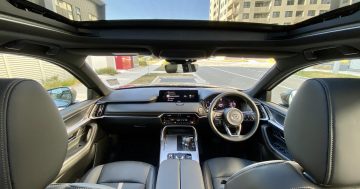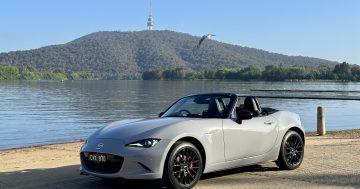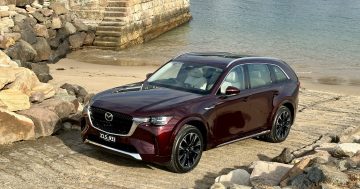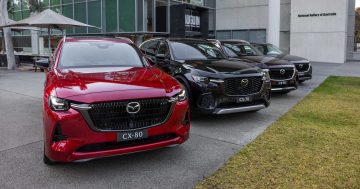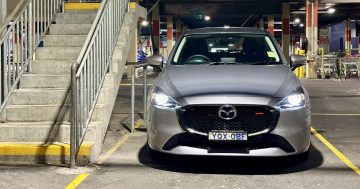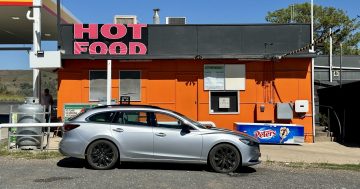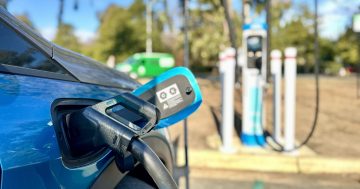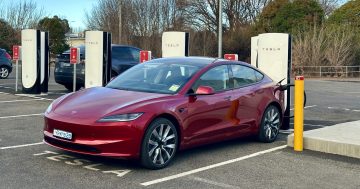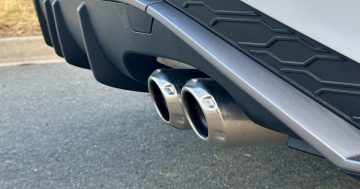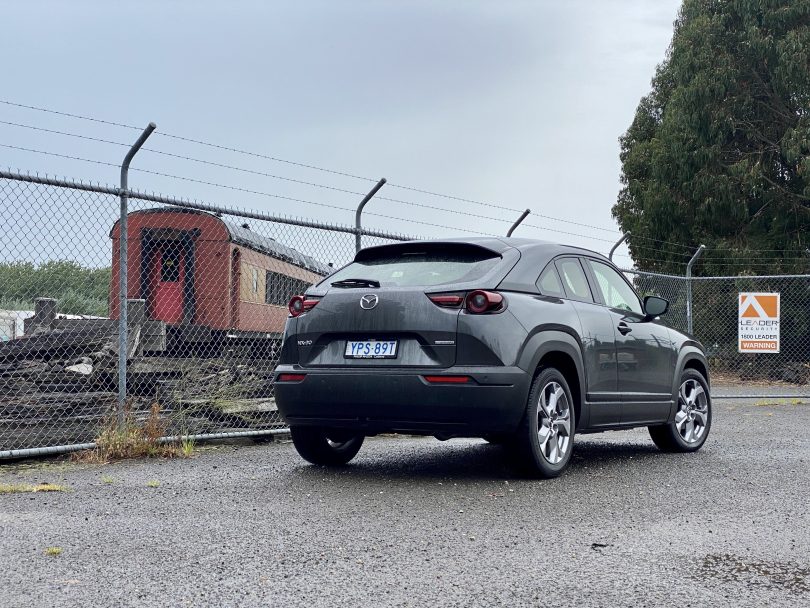
The all-new Mazda MX-30 arrived in Australia last year. Photo: James Coleman.
Kingston was where it all began. Formerly known as Eastlake and situated a mere 4 km from the city centre, Kingston was established in 1922, making it the first suburb in the new Australian Capital Territory.
Today, it is home to plenty of glimmer and glam on the lake foreshore and sparkly office buildings lining Canberra Avenue. I’m near the train station, though. Many of those national buildings that now stand tall and proud by Lake Burley Griffin began here as supplies on the back of railway carriages.
The backdrop contrasts sharply with my brand-new Mazda, apart from the fact there is drizzle in the air and both are grey.
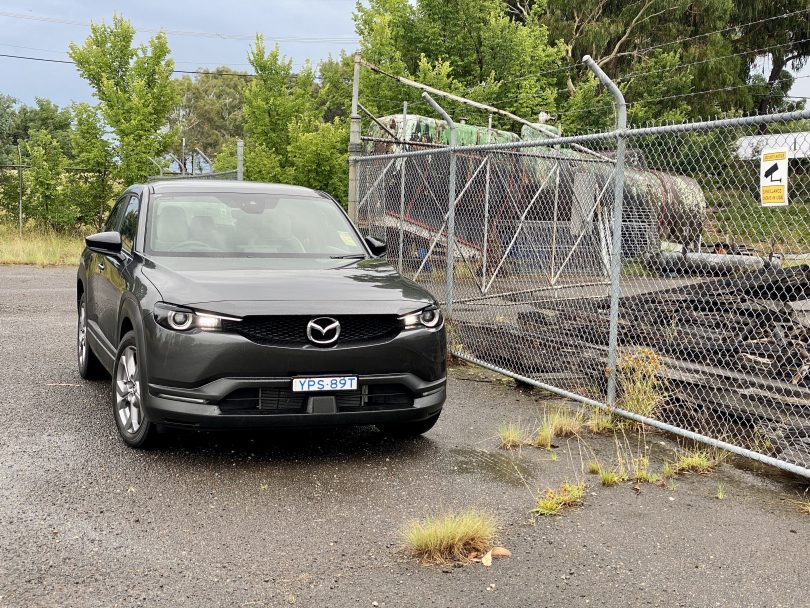
Old and rusty meets new and funky. Photo: James Coleman.
Mazda first graced the world as Toyo Cork Kogya Co, a cork factory in Hiroshima. From there, it was on to three-wheeled motorbikes and rifles before they settled on cars after World War II. They have since announced they are going upmarket, and they’re branching into electric vehicles.
To be honest, I don’t really know what this car is, apart from the fact it is the Japanese brand’s first-ever stab at an EV. It’s called the MX-30. Apparently, MX stands for ‘Mazda Experiment’. That much I can understand.
It has black plastic wheel arches and high-ground clearance like a conventional SUV, and at first glance, you might think it only has two doors like a coupe. However, open these doors, and you’ll find another handle to open a smaller back door to reveal one big portal to the entire cabin.
For those who know their Mazdas, ‘RX-8’ will spring to mind at this point.
Sales Manager from Phillip Mazda Samuel Bodley says it’s too early to tell what sort of people are buying the MX-30, “although a consistent characteristic is being interested in something new and different”.
“What we find is that if there is any intention to use the back seats, the MX-30 is off the table and the focus is on the CX-30.”
Trying to get my infant daughter into her car seat confirmed this.
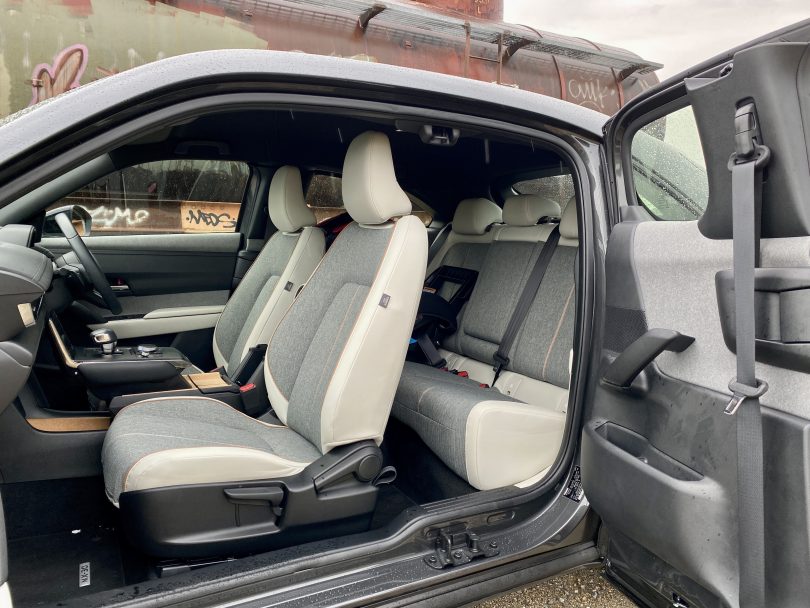
Should be easy to vacuum. Photo: James Coleman.
So if you’re buying the MX-30, it’s because you want an electric Mazda. Range is strictly ‘around-town’ at 224 km, and it’s only available in top-of-the-range Astina form, which means you’re looking at $65,490 (Tesla Model 3 money). But here it is.
Not so fast, though, because the particular model I’m driving is what Mazda describes as a ‘mild hybrid’.
It features a 2-litre petrol engine connected to what is basically a big alternator and a 24-volt battery. This gathers charge from the braking system and slightly boosts the total torque figure.
The ‘M-Hybrid’ model, Samuel says, easily outsells the electric due to the increased range and lower price.





This same drivetrain is also on offer in the CX-30 SUV and 3 hatch. This means you would now choose the MX-30 purely for style, and that’s odd because although it might be funky, it isn’t exactly pretty. A lot like modern art, really.
So what’s the rest of the package like?
One thing that immediately stands out is the interior. Between the front seats, the console is coated with a thin layer of cork as a nod to Mazda’s early days, while the top of the doors are trimmed in a material made from recycled plastic bottles. Even the seat fabric is recycled and ‘not washed in any solvents’.

The MX-30 also comes in two-tone colour scheme options. Photo: James Coleman.
You know these measures are not going to save the planet in the slightest, but they’re a nice bragging point. And it’s very pleasing to see car manufacturers moving away from underwear as their inspiration for interior design.
In middle-of-the-range Touring spec, you do have to fork out $1,400 extra for the ‘Vision Technology’ package just to score parking sensors on the front, which is odd for an up-and-coming premium brand.
More power also wouldn’t go astray, especially when Toyota makes hybrids that are faster off the line. Still, with the steering and suspension the way it is, I get the distinct impression that the electric version would certainly be a genuine blast to drive.
A brief foray next to the railway tracks in Kingston proves that, yes, those beefy wheels can actually go off the road.
If it’s meant to go off the road. I still don’t really know.

The Mazda MX-30 by the Glassworks Museum in Kingston. Photo: James Coleman.
Mazda MX-30 M-Hybrid
- $36,490 (plus driveaway costs)
- 2.0-litre four-cylinder petrol engine, with integrated starter generator (ISG) and 24V lithium-ion battery; 114 kW / 200 Nm
- Six-speed automatic; front-wheel drive
- 6.4 litres per 100 km fuel usage
- 5-star ANCAP safety rating.
This car was provided for testing by Phillip Mazda. Region Media has no commercial arrangement with Phillip Mazda.












